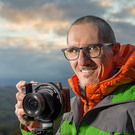-
Posts
1,724 -
Joined
-
Last visited
About Vieri
- Birthday 04/22/1970
Contact Methods
- Website URL
Profile Information
-
Member Title
Leica & Phase One
-
Gender
Male / Männlich
-
Location
San Ginesio, Italy
-
Country
Italia
Converted
-
City
San Ginesio, Italy
-
Job
Photographer
-
Your Leica Products / Deine Leica Produkte
Leica M10-R and various lenses
- Website
Recent Profile Visitors
1,197 profile views
-
Vieri started following Misty sunrises in Tuscany , filters and filter holders fro the S system. What do you use? , Leica S system being discontinued? and 1 other
-

filters and filter holders fro the S system. What do you use?
Vieri replied to Pierre68's topic in Leica S System
That was my solution as well, back in the day. Nowadays, NiSi offers a 95mm adapter ring for their Vxx system, which would be a better solution. Of course, if one doesn't need Grad NDs, the magnetic / round route is also possible. Best regards, Vieri -
Correct, I was referring to the way it is normally tested in practice, taking images of couple of lines, to give a "visual representation" that was easier to understand. It stands that the appendix people links to is, in fact, not quite correct in terms of how MTF is measured (and makes little sense to me). Best regards, Vieri
-
IMHO, the MTF appendix linked describes something that's actually not how MTF works. MTF curves are expressed in lines per mm, not in "1 is the best" as Roger mentions. MTF describes resolution in terms of contrast between pairs of lines any given lens can project onto the image recording surface. In simple words, the thinner the lines you can discern before they "melt" and don't look separate anymore, the higher a lens' "resolution". Let's see two cases: 1. Assume your lens can project an image discerning up to two separate lines that are one nanometer thick, with one nanometer of separation between them. Now, assume your sensor's pixels are 3 nanometers in size. The 1 nanometer lines are lost in the 3 nanometer-sized pixels, and the resulting image will show a single, 3-nanometers-thick line, not two separate one-nanometer-thick lines and the space between them. Hence, in layman's terms people say that the lens "outresolves" the sensor (whether the layman's terms are accurate, is a different story, but it doesn't change the facts). 2. Assume now that your lens can project an image discerning up to two separate lines that are three one nanometer thick, with three nanometers of separation between them. Now, assume your sensor's pixels are 1 nanometer. 3 lines of pixels will be used to represent one line as projected by the lens, 3 lines of pixel will represent the separatio, three more lines will represent the second line. Hence, in layman's terms people say that the sensor "outresolves" the lens (again, whether the layman's terms are accurate, is a different story, but it doesn't change the facts). In case 1., updating your sensor to one with smaller pixels (or with more pixels, sensor size being equal) will make fully use of the lens' MTF power, thus improving the system. On the other hand, getting lenses with better MTF won't help seeing more details in your images. In case 2., updating your lens will make fully use of the sensor's smaller pixels, thus improving the system. On the other hand, getting a sensor with smaller pixels (or with more pixels, sensor size being equal) won't help seeing more details in your images. Best regards, Vieri
-
Hey Tom, thank you very much, I am glad you enjoyed them! Best regards, Vieri
-
Thank you very much Stuart, so glad you enjoyed them! Thank you very much Lelmer, will do! Thank you very much indeed, happy you liked the series! Thank you very much, Andreas! Best regards, Vieri
-
Hey everyone! I just got back from over two weeks in the US leading Workshops, a week in Death Valley and one around the Southwest, and while I don't have any new images done yet, since I used my Phase One IQ4 Achromatic back pretty much exclusively during the trip, I got inspired to share some old B&W Leica work from Death Valley. Can't wait to be back to Death Valley in less than a month! Leica SL, Voigtlander 15mm Super Wide Heliar III, 5 minutes, f/11 Leica SL, Voigtlander 15mm Super Wide Heliar III, 2 minutes, f/11 Leica S (Typ 007), Leica 30-90mm at 75mm, 1/60 seconds, f/16 Thank you for viewing, best regards Vieri
- 9 replies
-
- 12
-

-

-
Thank you very much, that's really much appreciated! Thank you very much indeed! Hey David, glad my images brought up some good memories! Thank you very much indeed, glad you enjoyed them! Hey Graham, thank you so much, happy you liked them! Glad to be back here, even if for a short while Thank you very much wizard, glad you enjoyed them and #1 in particular! Hello Stuart, great to see you and happy you enjoyed these! Best regards, Vieri
-
Hello everyone, long time no see! I will be going back again to Tuscany soon, so I thought I'd share a few image of those beautiful landscapes shrouded in mist, at sunrise, taken over the years I was using the Leica SL: ...and one in B&W: Thank you for viewing & commenting, best regards Vieri
- 8 replies
-
- 24
-

-

-
Thank you very much indeed for your kind comment Brent, I am really happy you enjoyed it! Best regards, Vieri
-
They are indeed, love working with both!! Thank you very much indeed, happy you liked it! Best regards, Vieri
-
You are welcome. I don't speak german, so I have no idea what schlehen means in this context, sorry. About the diagonals, I mean the top-right -> mid-left diagonals in the clouds, and bottom-right -> mid left diagonals created by the slope where the huts lie. Hope this helps! Best regards, Vieri
-
Thank you very much Stuart, glad you enjoyed it! Best regards, Vieri
-
Indeed, thank you Jaap! Best regards, Vieri
-
Hello Suuumm55, thank you for your comment. Art appreciation is personal, of course, so I am totally fine with people having different opinions on my work, and I know perfectly well that nothing I can say will change your perception - I am afraid we'll just have to agree to disagree on this one. That said, there's my view and mental process behind this image. For me, the drama in the sky is complementing and strengthening the dramatic, jutting shape of the mountains, in contrast with the more pastoral feeling of the lower part of the image. More, compositionally the diagonal lines created by the long-exposed clouds work well with the diagonals created by the sloe in pointing towards the mountains and towards the brighter area of the sky. Thank you for your comment, Jaap. Good that you mentioned Ansel, since he dramatically changed his printing rendition of same negatives during the years, moving from lighter, brighter versions to darker ones. To me, the drama is accentuated by the relative darkness of the image (even though, the histogram covers all the spectrum, and all zones are represented), and applying a lift of the midtones would ruin that for me. Again, we'll have to agree to disagree. It's the beauty of this wonderful thing called photography that we all love, and that let us express ourselves and our emotions in the most varied ways - as many as there are people. Best regards, Vieri
-
Thank you very much, glad you enjoyed it! Yes indeed! Best regards, Vieri






